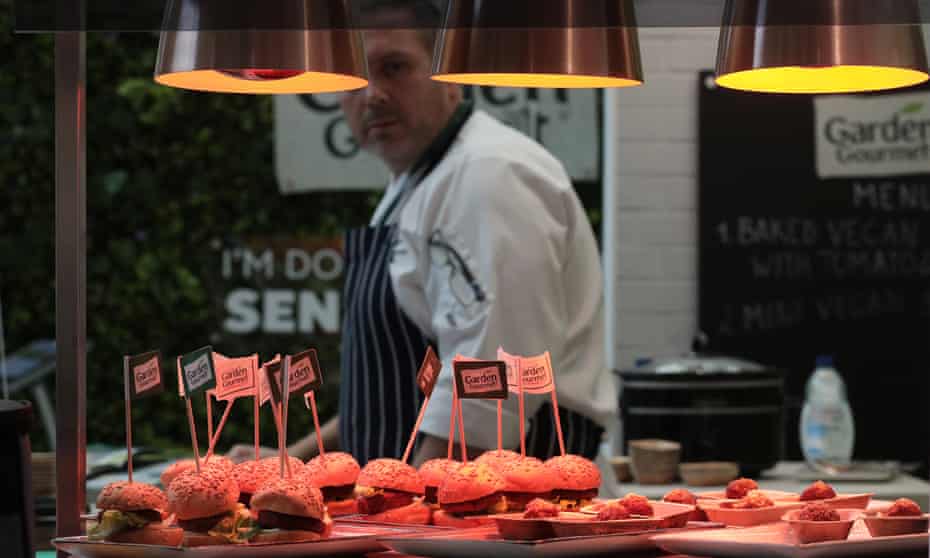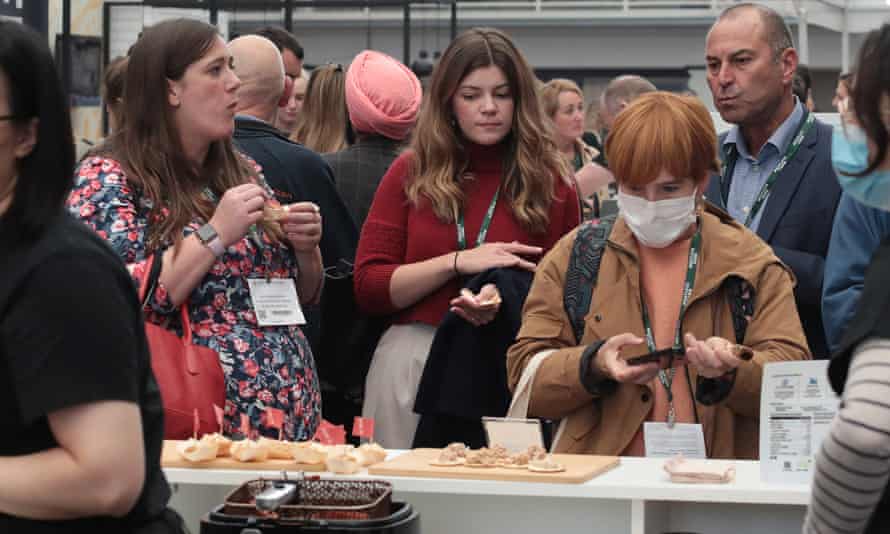Hail seitan: jackfruit pepperoni and meat-free lardons at Plant-Based World Expo
Meat, fish and dairy alternatives are in their wild west phase of discovery and invention

Heather Mills stood up on Friday morning at the Design Centre in Islington, before a modest but engaged audience, to give the keynote speech at the Plant-Based World Expo, the first exhibition of meat, fish and dairy alternatives in Europe. “I’ve got thousands of friends that are vegetarians,” she says, “but they just can’t get it over the line because of cheese.”
Of the many things you may not know about Mills, if all you knew was that she was once married to Paul McCartney, the cheese made by V-Bites, the company she founded, is maybe the most surprising. “Look at the way it pulls into a string,” says Joe Hill as he brandishes a slice of Hawaiian pizza, featuring meat-free bacon lardons from This Isn’t Bacon. Hill runs One Planet Pizza, a family business in Norwich, with his father, Mike. “V-Bites is the gold standard. There are still a lot of bad cheese experiences out there.”
Plant-based alternatives are in their wild west phase – an era of discovery, invention and mad rushes of blood to the head, though realistically, it is probably beetroot juice. Andrew Keeble founded Heck sausages, of regular meat, in 2013, and quickly commanded a large share of the premium processed pig market.
“But the vegan and vegetarian markets are crazy,” he says, explaining why he diversified. Well, almost explaining: “No one’s making any money. There are these huge valuations: Beyond Meat was valued at $2.5bn, it’s a very noisy market, but small and very juvenile.” Such a jostling field is bound to have its skirmishes and these are the main faultlines.

Are plant-based alternatives trying to turn everyone vegan, or play straight for the flexitarians, people who are just trying to take a day or two off eating meat? Pretty much only Mills is on an evangelical vegan kick. For everyone else, as Alice Edwards, head of retail at Jack & Bry, purveyors of gourmet jackfruit fake pepperoni among other things, puts it: “We’ve got to capture those meat eaters.” Vegans’ support has been banked, basically, and the big game is elsewhere. It’s a bit like being a member of the Labour party.
It’s not nothing, this meat-free-Monday trend. The Committee on Climate Change estimated that if all carnivores were to swap only 20% of their meat intake for fake meat, that would be enough (with other behavioural changes) to get us to net zero.
Michael Hunter, the managing director of Meatless Farms, is in the business of baby steps: if we all swapped out just one meal a week for a meat alternative, he says, the UK’s carbon footprint would drop by 8.4%. He then hands me a grilled “chicken breast” made of pea protein isolate. Pea is huge at the moment, ever since soy got a bad name, for health and sustainability reasons (it is impossible to overstate how bad this name is, now: “free from soy and other nasties” is a typical sentence). “Pea gives it the structure, wheat gives it the tear,” Hunter explains.
The speed of tech development in this area is remarkable. I remember only five years ago eating meat substitutes that tasted like a practical joke. Now you can eat a prawn made of seaweed or a katsu curry made of seitan and, if you weren’t concentrating, you would be perfectly satisfied that a living creature had died for your lunch. The only lingering question is, since it’s not a prawn, why does it taste like one? They flavour the brine with herbs and some sugar. But (sotto voce) which herbs? Since when was there a prawn herb?
Which brings us to the other big divide, between those trying to create textures and meat mimicry, or “frankenfood”: “burgers dripping with fake blood”, as Marcus Isaacs, Love Seitan’s sales manager describes. Seitan is, of course, also processed – wheat, gluten, nutritional yeast, chickpea flour, herbs and spices. But they’ve been eating it in Japan for hundreds of years. Pea protein isolate, on the other hand, and methyl cellulose – these are frontier products: you can love them or hate them, but they would not pass Michael Pollan’s test for good nutrition: “Don’t eat anything your great-grandmother wouldn’t recognise as food.”
On the flipside, there are those using regular ingredients and equipment no more complicated than a blender, to create foods that are merely shaped like meat (or fish). Gosh has an epic range of straight vegetables and pulses in patty shapes. Keeble has a fake sausage that has a very porky flavour, a number of pure vegetable-based sausage-shaped items, and a 60:40 meat and veg ratio, for the totally unabashed reducer, who only wants to eat a little less. “That’s like hiding vegetables on your kid’s plate,” Keeble says, “except you’re doing it to yourself.”
Spare a thought in all this for Crackd, trying to reproduce the many magical qualities of an egg; or Mouse, approximating a camembert with cashew, salt, water and culture. Humans may be ingenious to the point of making your head spin, but chickens and cows have mysteries of their own, which we have not yet unlocked. Although, to be fair to the egg substitute, I tasted it in a quiche. So I may have been objecting to the fake bacon.
